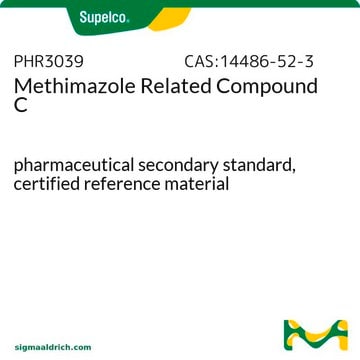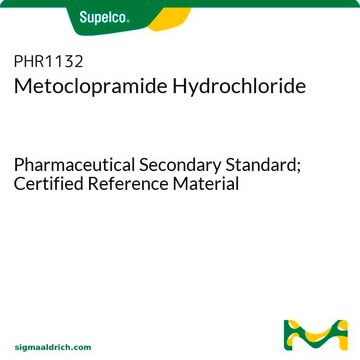1411038
USP
Methimazole Related Compound C
United States Pharmacopeia (USP) Reference Standard
Sinónimos:
1-Methyl-2-(methylthio)-1H-imidazole, 1-Methyl-2-(methylsulphanyl)-1H-imidazole
About This Item
Productos recomendados
grado
pharmaceutical primary standard
familia API
methimazole
fabricante / nombre comercial
USP
aplicaciones
pharmaceutical (small molecule)
formato
neat
temp. de almacenamiento
2-8°C
InChI
1S/C5H8N2S/c1-7-4-3-6-5(7)8-2/h3-4H,1-2H3
Clave InChI
LKIVEIAXFZBGMO-UHFFFAOYSA-N
¿Está buscando productos similares? Visita Guía de comparación de productos
Descripción general
For further information and support please go to the website of the issuing Pharmacopoeia.
Aplicación
- Nephrotoxicity Studies in Renal Cells: Methimazole Related Compound C was used in a study to explore the role of biotransformation and oxidative stress in 3,5-dichloroaniline-induced nephrotoxicity. This research provides insights into the cellular mechanisms affected by Methimazole and its related compounds(Racine et al., 2016).
- Phenytoin Teratogenicity Research: Investigations into the bioactivation of phenytoin, involving lipoxygenase-catalyzed reactions that may be relevant to Methimazole Related Compound C, provide critical data on the enzymatic pathways that contribute to drug-induced teratogenic effects. This research assists in the development of safer pharmaceuticals by identifying hazardous metabolites (Yu and Wells, 1995).
- Enzyme Inhibition Studies: The impact of thionamides and related compounds on enzyme activities was studied, highlighting how Methimazole Related Compound C affects important metabolic enzymes like trimethylamine oxidase. This is essential for developing medications that minimize adverse effects on metabolic processes (Pearson et al., 1982).
Nota de análisis
Otras notas
Producto relacionado
Código de clase de almacenamiento
10 - Combustible liquids
Clase de riesgo para el agua (WGK)
WGK 3
Punto de inflamabilidad (°F)
Not applicable
Punto de inflamabilidad (°C)
Not applicable
Certificados de análisis (COA)
Busque Certificados de análisis (COA) introduciendo el número de lote del producto. Los números de lote se encuentran en la etiqueta del producto después de las palabras «Lot» o «Batch»
¿Ya tiene este producto?
Encuentre la documentación para los productos que ha comprado recientemente en la Biblioteca de documentos.
Nuestro equipo de científicos tiene experiencia en todas las áreas de investigación: Ciencias de la vida, Ciencia de los materiales, Síntesis química, Cromatografía, Analítica y muchas otras.
Póngase en contacto con el Servicio técnico



